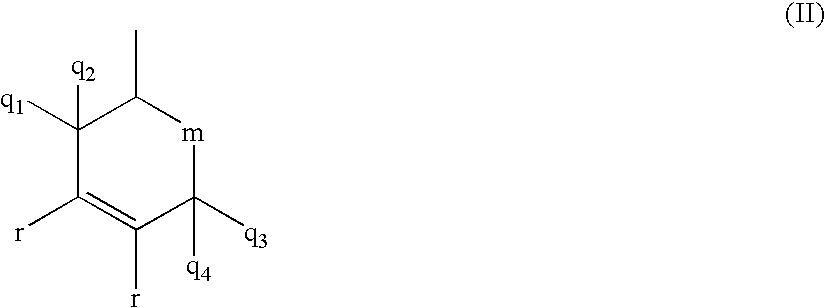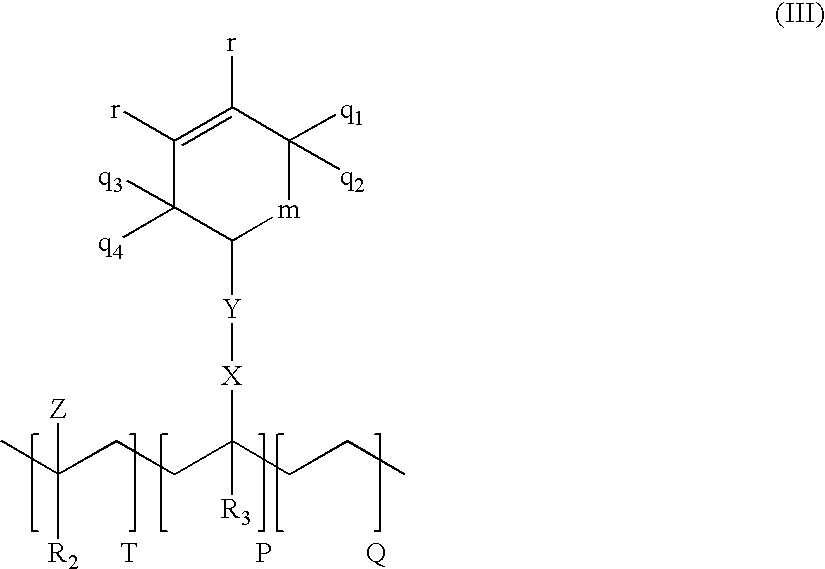Container having oxygen-scavenging core layer
a core layer and container technology, applied in the field of rigid polymer food or beverage containers, can solve the problems of weakening the physical integrity of multi-layer container structures, unpleasant odor and/or taste of oxidized materials, etc., and achieve the effect of prolonging the freshness and shelf li
- Summary
- Abstract
- Description
- Claims
- Application Information
AI Technical Summary
Benefits of technology
Problems solved by technology
Method used
Image
Examples
example 1
Preparation of EMCM
[0091]The preparation of EMCM and like polymers has been described, for example in U.S. patent application Ser. No. 09 / 127,316, the disclosure of which is incorporated herein by reference in its entirety.
[0092]In one example, 600 ml of decalin was placed in a flask. To this was added 334 grams of Chevron SP-2260 (0.9330 moles of methyl acrylate) and 0.44 g of Irganox® 1010 (0.1% mole). The temperature of the mixture was gradually raised while stirring. When the temperature reached approximately 120° C., 104.6 g (0.93 moles) of cyclohex-1-ene-4-methanol was added. When the temperature reached approximately 140° C., 4.4 g of the catalyst Ti(OC2H5)4 was added a portion at a time. The temperature was maintained at 160° C. while stirring. The course of the reaction was observed by subjecting samples of the mixture to NMR at hourly intervals. The percent conversion is given in Table 2 below. After 3 hours of reaction, the mixture was cooled and 400 ml of CHCl3 was added...
example 2
Preparation of PET / EMCM / PET Rigid Multi-layer Structures
[0099]Multilayer films were made on a Randcastle extruder. Commercial bottle grade PET was dried at about 150° C. for about 3 hours in a vacuum oven. The oxygen scavenging polymer was compounded on a Haake twin screw extruder at 170° C. from 90 wt. % EMCM and 10 wt. % EMAC based cobalt masterbatch (containing 1 wt. % BBP3 photoinitiator and 1 wt. % cobalt as cobalt oleate). The feedblock for PET was set to 265-290° C. and that for oxygen scavenging polymer was set to 170-180° C. The die temperature was set to 265-290° C.
[0100]Oxygen transmission testing was done on a Mocon Ox-Trans 2 / 20 ML system at 23° C. Nitrogen containing 2% hydrogen was used as carrier gas to flush both sides of the film at 10 cc / min flow rate for 1-4 hrs before testing. Air was used as test gas at 10 cc / min flow rate.
[0101]Tests were performed using Mylar film, unoriented monolayer film made from bottle grade PET, PET / OSP / PET unoriented 3-layer films test...
example 3
[0103]A PET / OSP / PET multilayer structure is made essentially as described in Example 2, except that the film is UV triggered with Mercury Arc UV lamp with long wavelength, e.g., 355 nm-375 nm, before OTR test.
PUM
| Property | Measurement | Unit |
|---|---|---|
| Temperature | aaaaa | aaaaa |
| Volume | aaaaa | aaaaa |
| Nanoscale particle size | aaaaa | aaaaa |
Abstract
Description
Claims
Application Information
 Login to View More
Login to View More - R&D
- Intellectual Property
- Life Sciences
- Materials
- Tech Scout
- Unparalleled Data Quality
- Higher Quality Content
- 60% Fewer Hallucinations
Browse by: Latest US Patents, China's latest patents, Technical Efficacy Thesaurus, Application Domain, Technology Topic, Popular Technical Reports.
© 2025 PatSnap. All rights reserved.Legal|Privacy policy|Modern Slavery Act Transparency Statement|Sitemap|About US| Contact US: help@patsnap.com



